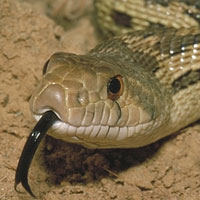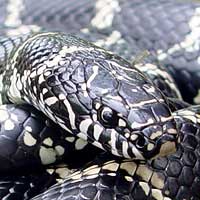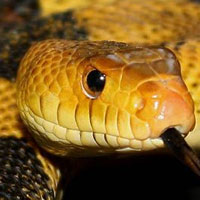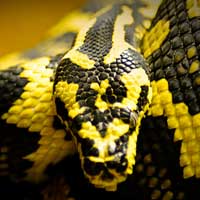Understanding and Caring for the Texas Rat Snake
The Texas Rat Snake, scientifically known as Pantherophis obsoletus lindheimeri, belongs to the Colubridae family, which is the largest family of snakes, encompassing a diverse range of non-venomous and mildly venomous species recognized for their adaptability and widespread distribution across various habitats.
Scientific Name: Pantherophis obsoletus lindheimeri
Snake Family: Colubridae
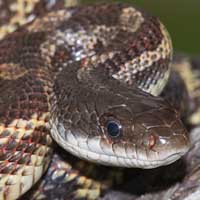
Introduction to the Texas Rat Snake
The Texas Rat Snake (*Pantherophis obsoletus lindheimeri*) is a non-venomous colubrid native to Texas and surrounding states. Renowned for its adaptability and bold nature, this snake is commonly found in a variety of habitats ranging from forests to urban areas. Its vibrant yellow and black pattern, along with its manageable size, makes it a popular choice among reptile enthusiasts. With proper care and understanding, the Texas Rat Snake can thrive in captivity and serve as a fascinating pet.
Crafting an Optimal Habitat for the Texas Rat Snake
The Texas Rat Snake thrives in diverse environments in the wild, and replicating these conditions in captivity is crucial. Key habitat requirements include:
- Enclosure Size: A minimum of a 40-gallon tank for adults, with additional space for enrichment.
- Temperature Gradient: Maintain a daytime range of 75-85°F with a basking spot at 90°F and nighttime temperatures between 65-70°F.
- Humidity: Keep humidity levels between 40-60%, achieved through light misting and a water dish.
- Substrate: Use aspen shavings, cypress mulch, or a sand-soil mix to replicate natural ground cover.
- Enrichment: Provide branches, climbing opportunities, and hides for exploration and security.
Below is a habitat setup table for quick reference:
| Habitat Element | Specifications |
|---|---|
| Enclosure Size | 40+ gallons |
| Temperature | 75-85°F (day), 65-70°F (night) |
| Humidity | 40-60% |
| Substrate | Aspen shavings, cypress mulch, sand-soil mix |
Feeding Your Texas Rat Snake: Dietary Insights
The Texas Rat Snake is an opportunistic carnivore, feeding primarily on rodents and birds in the wild. In captivity, its diet is simple and manageable:
- Juveniles: Feed pinky mice every 5-7 days.
- Subadults: Offer small to medium-sized mice every 7-10 days.
- Adults: Provide adult mice or small rats every 10-14 days.
- Prey Type: Use pre-killed prey to prevent injuries and reduce stress during feeding.
- Hydration: Ensure a fresh water supply in a shallow dish, replaced daily.
A consistent feeding schedule supports growth, health, and vitality in your Texas Rat Snake.
Behavior and Temperament of the Texas Rat Snake
The Texas Rat Snake is known for its bold and inquisitive nature. Here’s what you need to know:
- Active Hunters: These snakes are diurnal and actively seek out prey, making them engaging to observe.
- Climbing Skills: They are excellent climbers, so providing vertical space and branches is essential.
- Temperament: While typically docile in captivity, wild individuals may exhibit defensive behaviors such as hissing or striking.
- Stress Indicators: Excessive hiding, refusal to eat, or unusual behavior can signal stress or unsuitable conditions.
Creating a secure and enriched environment helps reduce stress and encourages natural behaviors.
Health and Lifespan of the Texas Rat Snake
With proper care, the Texas Rat Snake can live 15-20 years in captivity. Key health considerations include:
- Common Health Issues: Respiratory infections, improper shedding, and mite infestations are typical concerns.
- Preventative Measures: Maintain stable environmental conditions and ensure cleanliness in the enclosure.
- Veterinary Care: Regular check-ups with an exotic animal vet can prevent potential health issues.
- Observation: Monitor for signs of illness, such as lethargy, loss of appetite, or wheezing.
Proactive care ensures a long and healthy life for your snake.
Breeding and Reproduction of the Texas Rat Snake
Breeding the Texas Rat Snake in captivity requires careful preparation. Key factors include:
- Breeding Season: Typically occurs in spring following a winter cooling period.
- Clutch Size: Females lay 6-12 eggs per clutch.
- Incubation: Eggs should be incubated at 80-85°F for 50-60 days.
- Hatchling Care: Provide small enclosures and appropriately sized prey for hatchlings.
Successful breeding requires attention to environmental conditions and the health of the breeding pair.
Handling and Caring for the Texas Rat Snake
Handling and caring for the Texas Rat Snake is straightforward with the right approach. Follow these tips:
- Handle the snake gently, supporting its entire body to minimize stress.
- Avoid handling immediately after feeding to prevent regurgitation.
- Provide enrichment such as climbing structures and hides to mimic natural behaviors.
- Maintain a regular cleaning and feeding schedule to ensure their health and well-being.
- Monitor behavior and health to identify and address issues early.
By providing proper care and attention, the Texas Rat Snake can become a fascinating and low-maintenance pet.
Other Snakes In This Species
 Aesculapian Rat Snake
Aesculapian Rat Snake Amur Russian Rat Snake
Amur Russian Rat Snake Bairds Rat Snake
Bairds Rat Snake Black Rat Snake
Black Rat Snake Chinese Twin-spotted Rat Snake
Chinese Twin-spotted Rat Snake Diadem Rat Snake
Diadem Rat Snake Diones Rat Snake
Diones Rat Snake Eastern Fox Snake
Eastern Fox Snake Everglades Rat Snake
Everglades Rat Snake Four-lined Rat Snake
Four-lined Rat Snake Gray Rat Snake
Gray Rat Snake Great Plains Rat Snake
Great Plains Rat Snake Green Rat Snake
Green Rat Snake Ladder Rat Snake
Ladder Rat Snake Leopard Rat Snake
Leopard Rat Snake Mandarin Rat Snake
Mandarin Rat Snake Radiated Rat Snake
Radiated Rat Snake Steppes Rat Snake
Steppes Rat Snake Texas Rat Snake
Texas Rat Snake Trans-Pecos Rat Snake
Trans-Pecos Rat Snake Trinket Rat Snake
Trinket Rat Snake Yellow Rat Snake
Yellow Rat Snake



